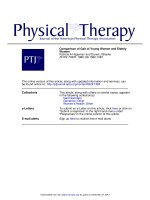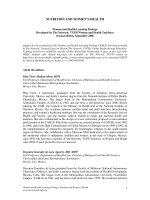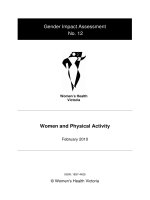Women and mathematics
Bạn đang xem bản rút gọn của tài liệu. Xem và tải ngay bản đầy đủ của tài liệu tại đây (1.26 MB, 57 trang )
Women and Mathematics
Jean E. Taylor
ΦΒΚ Visiting Scholar
Courant Institute of Math Sciences, NYU
math.rutgers.edu/~taylor
Pop quiz (now, 20 & 40 yrs ago)
1. a. What percentage of bachelor’s degrees in
math is now awarded to women (in U.S.)?
b. Same for Ph.D. degrees?
2. In studies of “math talented youth” (e.g. at age
13, scoring over 700 on math SAT), what is the
ratio of boys to girls?
3. What kinds of cognitive differences have been
found by scientific studies? In particular, how
different are spatial abilities?
4. What percentage of tenured positions at
doctoral-degree-granting math departments (in
American universities) is held by women?
Some faces of women in math
Becca Thomases
(at NYU last year)
Cynthia Rudin
Jean Steiner
A picture is worth a thousand words … but takes up 300 times the memory.
4 years of math in high school?
• 1998: sex differences in high school
math participation (including calculus)
had disappeared. (Still differences in
“optional” courses like statistics, in 1990.)
• 1960: 33% of boys, 9% of girls
• Sells 1973 study of random sample of
freshmen entering UC Berkeley: 57% of
males, 8% of females. (Lots of publicity!)
But 1972 large national study : 39% of
males, 22% of females. (Little publicity!)
Percentage of bachelor’s degrees
in math now going to women?
• Answer: About 50%.
• Earlier data:
1949-50: 24% of all BA degrees to women, 23% of BA
degrees in math to women.
1976-77: 46% of BA degrees to women, 42% in math to
women.
• Grades of women in similar math courses are at
least as good as men’s.
• Big difference is in physics and engineering;
often lumped with math. More on that later…
But (NYTimes, 7/9/06),across all fields:
“The idea that girls could be ahead is so shocking that
they think it must be a crisis for boys,” Ms. Mead said.
“I’m troubled by this tone of crisis. Even if you control
for the field they’re in, boys right out of college make
more money than girls, so at the end of the day, is it
grades and honors that matter, or something else the
boys may be doing?”
Or something the hirers are doing? I’ll come back to
that later.
Ph.D.’s in math to women?
• Now: about 30%
• 1968 (e.g.,by my count, from published names) : 6%.
Ingrid Daubechies
Alice Chang
Tenured women in math at Princeton University (2 of 32)
NYAS symposium on The Nature and Nurture of Women in Science April 4,2005,
from summary of talk of Richard Haier, UC Irvine:
Bell curves of male and female IQ scores "essentially completely overlap," Haier
said. This overlap can be found in bell-curve graphs of measures of many cognitive
functions, including visual, spatial, and mathematical reasoning. "But the
controversy," he said, "is why there are so many more men out there on the extreme
than women.“…Test-score statistics, however, point to a considerable difference in
the numbers per gender of extremely able people in math reasoning—people who fill
the top ranks of scientists in certain fields. … Some studies have suggested that the
ratio of males to females with extreme math-ability is 10 to 1. Though that number
may not be completely accurate, Haier said, it suggests the scale of the difference.
BUT IT DOES NOT, and HIS GRAPHS (below) ARE NOT BASED ON ANY DATA!
“Math-talented youth”
• Benbow and Stanley (1980, 1983) (Johns
Hopkins data): male:female ratio among
13-year-olds scoring over 700 on math
SAT was 13:1. Huge publicity!
• Subsequent Johns Hopkins data, Duke
data have showed decreasing ratios; by
late 1990’s, down to under 3:1 (2.8:1)
(I don’t know of any more recent data). No sign that
not still falling.
• Furthermore B-S Methods did not ensure
representative sampling; other issues.
`Ms. Benbow, a widely published scholar, said
she stood completely by the research in the
three articles…’ (Education Week 2006)
• She doesn’t talk about the more recent data.
• She made her reputation on these studies;
she was recently appointed to National
Science Board by Pres. Bush and confirmed
by the Senate
• Newspapers and magazines, and even one
author in Gender Differences in Mathmatics,
still use only the 13:1 figure!
Cathleen Morawetz, Marsha Berger,
Margaret Wright – all at NYU, all
members of the National Academy of
Sciences. Morawetz got a National
Medal of Science + big Canadian prize
From the NYAS symposium:
• Linda Gottfredson, professor in the School of
Education and affiliated faculty in the University Honors
Program at the University of Delaware, however, argued
that innate gender differences are very clear—so clear,
in fact, that a goal of gender parity in all professions
seems unrealistic. Specifically, she said, male minds
show a bias toward interest in things, while female minds
are interested in people, creating what she called a
genetic "tilt" that affects the types of careers they
choose. In this light, supporting an idea of infinite human
malleability "ignores both women’s own preferences and
the huge challenges they face when committed to having
both children and careers."
I will show that “innate gender differences” are NOT at all
clear! And women DO prefer math as much as men! Issue
of children+careers is big, not just for scientists.
What kinds of cognitive differences
found by scientific studies?
• No difference between males and females on
measures like paper folding, embedded
figures, two-dimensional rotation where
required to reason about spatially present
information; large differences for tasks
requiring the rapid mental rotation of 3-D
objects presented as 2-D drawings.
(1985: Linn and Petersen meta-analysis on on available studies.
• Significant difference on math SAT (one-half a
standard deviation)
From Haier’s NYAS talk:
Major difference between men and women: men produce more testosterone,
all the time; women more progesterone and estrogen, in a monthly cycle.
Biochemical pathways for hormones, from The Female Brain
Research since the Linn-Peterson meta-analysis
indicates that differences with regard to mental
rotation have diminished and are amenable to
instruction.
“Longitudinal studies show that
spatial abilities are related to early experiences such
as the amount of time spent playing with blocks.
(from The Female Brain book)
Mental rotations of actual 3D objects, rather than 2D
pictures, show no gender difference (from Gender
Differences in Mathematics).
What does all this have to do with how
women do mathematics? There are very
rarely any strong relationships between
measures of spatial reasoning and
measures of mathematical achievement
when general ability is controlled; many
literature reviews have concluded there is
no relationship.
Also, there is more than one way to do
math.
(driving around Princeton anecdote)
• SAT items that produced the greatest
gender differences for U.S. students
produced no gender differences for
Chinese and Japanese students. (Byrnes,
(Japanese and Chinese elementary
school children tend to disagree with statements
like “The tests students take show how much or
how little natural ability they have.” U.S. children
tend to agree. (Stevenson, Stigler et al.,Learning Gap))
2004).
What makes some research much
better than other?
• Peer-reviewed (by experts chosen NOT by
the author but by an impartial authority
such as a journal editor) and published in
a journal or series known to have high
standards
• Replicable – other people can redo the
experiment, or the steps of the proof, etc.
• References are relevant to the case cited,
graphs based on real data, etc.
• Up-to-date, state-of-the-art
More myths unsupported by data
(from Los Angeles Times article reprinted in Cape Cod Times, October 8, 2006)
• “The sexes see and hear quite differently.” Fact: No
evidence from peer-reviewed studies
• “Women use both sides of brain more symmetrically
due to larger corpus callosum.” Fact: No statistically
significant differences in size or shape of corpus
callosum.
• “Boys biologically programmed to focus on objects,
girls on people.” Fact: This idea based on one study
of day-old babies, demolished by experts. (experiment
lacked critical controls, including fact that day-old infants can’t
hold up their heads independently, and were seated on
parents laps)
• “Boys deductive, girls inductive.” Fact (once it’s peerreviewed!): data on 1,000’s finds no difference.
“Stereotype Threat”
anxiety about confirming a negative stereotype
of one's gender or other social category
• The threat of being personally reduced to these
gender stereotypes can evoke a disruptive
state that undermines women’s math
performance.
(Davies & Spencer in Gender Differences in Mathematics)
• Biological basis seems to be increase in cortisol
levels, which can be measured even when
subjects say they don’t feel anxious (Ben-Zeev et
al).
Joshua Aronson, NYU:
• Nature made us very cultural animals, and
cultural environment (like the stereotype that
girls don't like math) has an impact on
performance. In particular, it affects test
performance.
How to study stereotype threat?
• Tell students prior to test that this test in the
past has revealed no gender differences. (Don’t
tell control group that.) Then women in control
group underperformed men, but no such deficit
if told no gender difference (Spencer et al
1999).
• Tell students the test is not diagnostic of their
math abilities. Again, completely eliminated
deficit (Davies, et al 2002)









